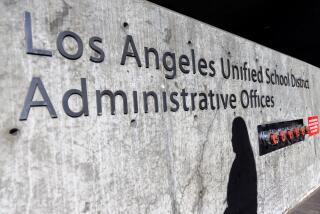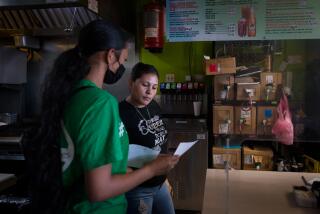BUENA PARK : Students Get Lessons on AIDS Prevention
- Share via
Thirteen-year-old Stephen Agosto says AIDS isn’t a subject he would talk about at home.
“Parents might be embarrassed,” said the Buena Park Junior High School eighth-grader. “If we’re going to learn it, it should be in the classroom.”
Classmate Lucy Huerta agreed: “You learn more (in the classroom) than with your parents because it’s taught by a nurse and she tells us more specific stuff.”
In efforts to reduce the spread of AIDS, Buena Park School District last week brought AIDS prevention education into the classroom.
Eighth-grade students were the first to receive a lesson about AIDS.
“It’s a good thing that they’re doing something about it because it’s not a subject to be avoided,” said eighth-grader Erica Brewer. “AIDS doesn’t choose blacks, whites, gays or lesbians. It affects everyone--if you don’t protect yourself.”
District trustees adopted the AIDS curriculum--which will be taught to sixth-, seventh- and eighth-grade students--in July.
The program is taught by Janice Ries, the district’s nurse and coordinator of health services, and Phyllis Reed, the district’s substance abuse teacher.
“The purpose (of the program) is to keep you from ever contracting AIDS,” Reed told students during a morning class.
The first class gave students an introduction to the reproduction and immune systems. The class is taught during science period and will continue for another week. Through lectures, videos and role-playing, students will learn about AIDS, and how to overcome peer pressure and make the right decisions.
Seventh-graders will go through the program next month. During the spring semester, all three upper grades will be receiving the instruction.
Sandra Barry, assistant superintendent of educational services, said students must obtain permission from their parents before going through the program. Parents can deny permission for their children to participate.
Agosto said his mother was hesitant about him taking the course. But he said he persuaded her to give permission.
Barry said the focus of the program is to emphasize that the safest way to reduce students’ risk of getting the deadly disease is to abstain from sex and drugs.
“We’re not teaching (safe) sex--we’re teaching abstinence. That is the way you don’t get the disease,” Barry said.
Most importantly, Barry said students get accurate and factual information about the disease.
“They get straight information,” she said. “If they don’t get straight information now, they may not live.”
Catherine France, an eighth-grade chemistry teacher, said her students have been eager for the program to start.
“There has been extreme interest and curiosity,” France said.
France, a teacher for 20 years, said junior high school students need and want such information.
“At this age, they’re terribly interested in anything that concerns themselves or their bodies,” she said.
Students agreed that awareness about the disease will save lives.
“It’s the new fear of the future,” said eight-grader Trevor Wilkinson. But through such school prevention programs, he said, “it’ll cut down on deaths.”
More to Read
Sign up for Essential California
The most important California stories and recommendations in your inbox every morning.
You may occasionally receive promotional content from the Los Angeles Times.










